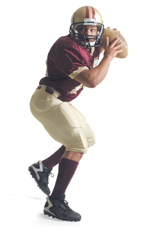
Football Injury Prevention
Football is the leading cause of school sports injuries. According to the U.S. Consumer Product Safety Commission, in 2012, approximately 466,492 people were treated for football-related injuries in hospital emergency rooms.
Proper Preparation for Play- Maintain fitness. Be sure you are in good physical condition at the start of football season. During the off-season, stick to a balanced fitness program that incorporates aerobic exercise, strength training, and flexibility. If you are out of shape at the start of the season, gradually increase your activity level and slowly build back up to a higher fitness level.
- Pre-season physical. All players should have a pre-season physical to determine their readiness to play and uncover any condition that may limit participation.
- Warm up and stretch. Always take time to warm up and stretch, especially your hips, knees, thighs and calves. Research studies have shown that cold muscles are more prone to injury. Warm up with jumping jacks, running, or walking in place for 3 to 5 minutes. Then slowly and gently stretch, holding each stretch for 30 seconds.
- Cool down and stretch. Stretching at the end of practice is too often neglected because of busy schedules. Stretching can help reduce muscle soreness and keep muscles long and flexible. Be sure to stretch after each training practice to reduce your risk for injury.
- Hydrate. Even mild levels of dehydration can hurt athletic performance. If you have not had enough fluids, your body will not be able to effectively cool itself through sweat and evaporation. A general recommendation is to drink 24 ounces of non-caffeinated fluid 2 hours before exercise. Drinking an additional 8 ounces of water or sports drink right before exercise is also helpful. While you are exercising, break for an 8 oz. cup of water every 20 minutes.
Protective equipment is one of the most important factors in reducing the risk of injury in football. According to Pop Warner Football, Official Rule Book, players should have the following protective gear:

- Helmet
- Shoulder pads, hip pads, tail pads, knee pads
- Pants (one piece or shell)
- Thigh guards
- Jersey
- Mouth guard (A keeper strap is required.)
- Athletic supporter
- Shoes (In some leagues, players can wear sneakers or non-detachable, rubber cleated shoes. Detachable cleats of a soft-composition also are allowed in some leagues. Check with your coach about the type of shoe allowed in your league.)
- If eyeglasses must be worn by a player, they should be of approved construction with non-shattering glass (safety glass). Contact lenses also can be worn.
- Coaches should be knowledgeable about first aid and be able to administer it for minor injuries, such as facial cuts, bruises, or minor strains and sprains.
- Be prepared for emergencies. All coaches should have a plan to reach medical personnel for help with more significant injuries such as concussions, dislocations, contusions, sprains, abrasions, and fractures.
An injured player's symptoms must be completely gone before returning to play. For example:
- In case of a joint problem, the player must have no pain, no swelling, full range of motion, and normal strength.
- In case of concussion, the player must have no symptoms at rest or with exercise, and should be cleared by the appropriate medical provider. Both the American Academy of Pediatrics and the American Academy of Neurology have established guidelines recommending that athletes with concussions be evaluated and cleared by a doctor trained in managing concussions before returning to sports.
Here are some additional strategies for parents and coaches to help young athletes prevent back-to-school sports injuries:
- It is important for your child to stay active during the summer, so that he or she is prepared to begin participating in fall sports.
- During practices, have children take frequent water breaks to prevent dehydration and overheating.
- Learn to recognize early signs of pain and discomfort in children, and teach children to be aware of those signs as well. Let them know they should notify their coach or parent as soon as they experience any pain.
- Avoid the pressure that is now exerted on many young athletes to overtrain. Listen to your body and decrease training time and intensity if pain or discomfort develops. This will reduce the risk of injury and help avoid burn-out.
Source: http://orthoinfo.aaos.org/topic.cfm?topic=A00113
